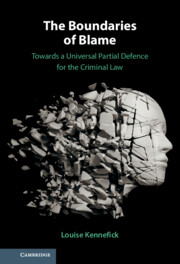Introduction
Published online by Cambridge University Press: 26 July 2025
Summary
This book is prompted by a concern that those who offend are blamed too much when they are held criminally responsible, suggesting that the law is running at a moral and social justice deficit. This concern represents an enduring criticism of the criminal law which is variously characterised as a failure to recognise crime as a social problem, its subjects as real people, or its own role in perpetuating injustice through its doctrine and principles of responsibility. In response, the book argues that the boundary placed around what factors can and cannot be included in assessments of culpability, and the apparent red line drawn between guilt and non-guilt, are both more permeable and less definitive than the law might have us think. The introduction explains and summarises the core arguments to support a Universal Partial Defence for the criminal law, based on a Real Person Approach to blaming people.
Information
- Type
- Chapter
- Information
- The Boundaries of BlameTowards a Universal Partial Defence for the Criminal Law, pp. 1 - 6Publisher: Cambridge University PressPrint publication year: 2025
Accessibility standard: Inaccessible, or known limited accessibility
Why this information is here
This section outlines the accessibility features of this content - including support for screen readers, full keyboard navigation and high-contrast display options. This may not be relevant for you.Accessibility Information
Content Navigation
Allows you to navigate directly to chapters, sections, or non‐text items through a linked table of contents, reducing the need for extensive scrolling.
Provides an interactive index, letting you go straight to where a term or subject appears in the text without manual searching.
Reading Order & Textual Equivalents
You will encounter all content (including footnotes, captions, etc.) in a clear, sequential flow, making it easier to follow with assistive tools like screen readers.
Visual Accessibility
You will still understand key ideas or prompts without relying solely on colour, which is especially helpful if you have colour vision deficiencies.
You benefit from high‐contrast text, which improves legibility if you have low vision or if you are reading in less‐than‐ideal lighting conditions.
